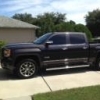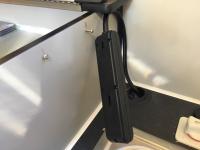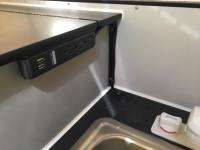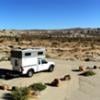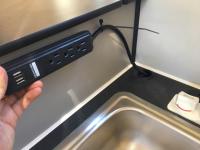

Adding a 110 volt outlet inside a FWC Hawk
#11

Posted 15 August 2017 - 01:11 PM

Chris
2014 GMC Sierra All Terrain 1500
2016 FWC Raven
#14

Posted 15 August 2017 - 01:51 PM
That's a sweet ^^^ mod that I will definitely implement! Thanks
These projects keep costing me $$ if not adding up on the list. ![]()
#15

Posted 15 August 2017 - 03:37 PM
The photos of the outlets close to the sink lead me to ask this related question (for anyone).....
Is there ground-fault protection somewhere in the standard FWC/ATC shorepower setup? (I can't just go check my camper because my shell doesn't have a standard shorepower setup-- I use an extension cord through a turnbuckle opening).
If so, where is it? Each outlet? First outlet in a circuit of multiple outlets? Each 110v breaker? Dogbone?
'01 FWC Hawk shell on a '13 Tundra Double-Cab + '19 Ford Transit van with Quigley 4x4 option
#16

Posted 15 August 2017 - 03:42 PM
and then a inverter for a cooktop and toaster later on.
Boy, I'm having a hard time wrapping my head around an inverter for an induction cooktop and a toaster (oven or bread?).
My first camper interior build was an all electric camper (no propane) with the 110 VAC side of things... Microwave, Induction Cooktop, Toaster Oven and a Wall Heater powered by my Honda 2000 generator. Here's my build thread... ATC Bobcat Shell - Owner Interior Build.
The Microwave was 600 watts, the Induction Cooktop was 1,500 watts, the Toaster Oven was 1,500 watts and the Wall Heater was 1,000 watts. If you're not talking about a toaster oven and instead talking about a home bread toaster, my two slice unit is 1,000 watts. And, we had a Rice Cooker at 300 watts, I was amazed at what the wife could cook in that, not just rice, everything from perfect hard boiled eggs, to stews, to slow cooked meats (just google rice cooker meals).
Using my Honda 2000 generator I could only have one of those items ON at a time. The microwave, the induction cooktop and the toaster oven did cycle ON & OFF when operating, and you could tell by the generator cycling UP & DOWN in rpm's as the units did the same. The Rice Cooker just had the Honda generator idling along, never did cycle up the rpm's, could hardly know it was ON standing almost right next to it. And, the Wall Heater had the Honda generator at high rpm's when turned on (we didn't use it after 9pm or before 7am). Usage times in preparing a meal was often about 20 - 30 minutes for all units combined. Then the Honda was turned off until the next major meal.
It was sweet to have the microwave for quick things, the induction cooktop for pan and pot prepared things, the rice cooker for things that were usually impossible while camping, and the toaster oven for homemade bread, muffins, and cookies.
How much battery power does a person need to power an inverter for the above mentioned wattage & time use?
Edited by Alley-Kat, 15 August 2017 - 06:34 PM.
#17

Posted 15 August 2017 - 05:03 PM
How much battery power does a person need to power an inverter for the above mentioned wattage & time use?
More than I want to put in my camper! Wow, that's a lot of load. I recall reading your thread a year or two ago and noting that you eventually switched out a lot of the electric stuff. Loved the idea of a microwave though!
To answer your question, I'm thinking of adding just a small (sub 1000w) induction cooktop. To keep it simple, let's just say the load is 1000w and that all power conversion is "perfect" and without losses. And I will only use it for one hour a day. And let's say I don't want to drop my batteries much below 12.2V.
1000w translates to 1000w / 12.2v = 82 Amps
And running that for one hour means I am consuming 83 AH.
I would need a battery at least 2x that AH capacity to avoid running them down below 50%, meaning 166 AH or more.
I happen to have 220 AH on tap, so I may just try this!
Now I am ducking and waiting for the real experienced and clever folks on line here to help me understand where I might have missed an important bit ![]()
![]()
![]()
2012 ATC Puma Shell build - https://www.wanderth...012-puma-build/
Power considerations thread - https://www.wanderth...e-power-scotty/
Building out an electrical system - So, you want to setup a good electrical system in your camper? - Electrical, Charging, Solar, Batteries and Generators - Wander the West
#18

Posted 15 August 2017 - 05:52 PM
Lee
#19

Posted 15 August 2017 - 06:08 PM
Vic, Thanks.
You'll find the ON-OFF cycling of the induction cooktop will directly be affected by the heat selection setting. The higher the heat selection setting the more the cooktop has to be ON, and the less time it is going to be OFF. Only at the highest heat selection setting will the induction cooktop be ON 100% of the time used. And, the lower heat selection setting will be mostly OFF with short bursts of time being ON. So, 83 Ah, is the calculated Max (who runs an induction cooktop for an hour? Good for a simple calculation though), and you could be lower and know it by your battery monitoring system.
I would recommend that you purchase the induction cooktop, along with some of the cookware (if you don't have any right now), and try it out in your home kitchen. That's what I did to get a feeling on what foods require what heat selection setting.
An interesting test report would be to chart the heat selection settings on the induction cooktop vs the battery amp hours used (listing the specifications of the inverter used, of course).
Get on it, once you get your induction cooktop, OK?
Even though I don't have the induction cooktop in the camper I still use it when; visiting neighbors for a big dinner, at block parties, on the boat with the engine running (thus creating a lot of 110 VAC). It's a great cooking resource in a little package.
#20

Posted 15 August 2017 - 06:10 PM
If you already have propane, I am not sure I understand the advantages of an induction cook top. What am I missing?
2016 Fleet Flatbed
2016 Toyota Tacoma
0 user(s) are reading this topic
0 members, 0 guests, 0 anonymous users



